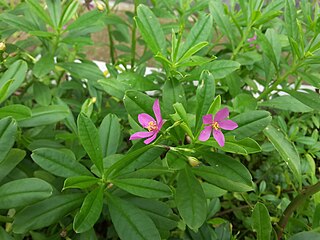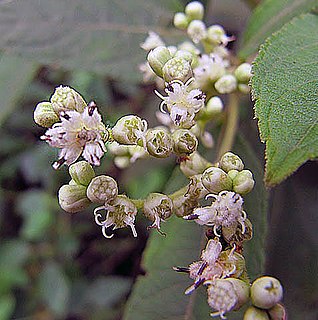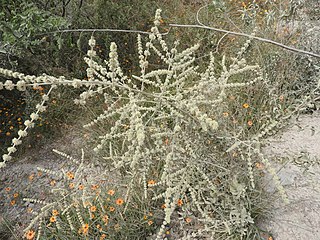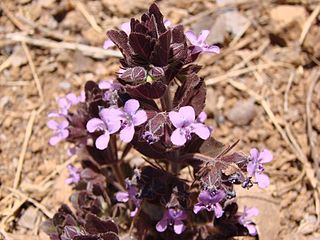
Antennaria is a genus of dioecious perennial herbs in the family Asteraceae, native to temperate regions of the Northern Hemisphere, with a few species in temperate southern South America; the highest species diversity is in North America. Common names include catsfoot or cat's-foot, pussytoes and everlasting.

The creeping zinnias are plants belonging to the sunflower family. They are native to mostly to Mexico, with a few species in Central America, South America, and the Southwestern United States.

Talinum paniculatum is a succulent subshrub in the family Talinaceae that is native to much of North and South America, and the Caribbean countries. It is commonly known as fameflower, Jewels-of-Opar, or pink baby's-breath.
Acanthospermum humile is a species of plants in the family Asteraceae. It is native to the West Indies but naturalized in parts of South America, Central America, and North America.

De Fructibus et Seminibus Plantarum, also known by its standard botanical abbreviation Fruct. Sem. Pl., is a three-volume botanic treatise by Joseph Gaertner. The first volume was published in December 1788. The second volume was published in four parts, in 1790, 1791, 1791 and 1792 respectively. A third volume was published after Gaertner's death by his son Karl Friedrich von Gaertner from 1805 to 1807; this final volume is also known as 'Supplementum Carpologicae', abbreviated as Suppl. Carp.. Most of the illustrations for the work were done by Johann Georg Sturm (1742-1793).

Clibadium is a genus of flowering plants in the sunflower family.
Oblivia is a genus of flowering plant in the sunflower tribe within the daisy family.

Pseudogynoxys is a genus of flowering plant in the groundsel tribe within the sunflower family, native to North and South America.

Pulicaria is a genus of flowering plant in the sunflower family, native to Europe, Asia, and Africa. In North America Pulicaria is known by the common name false fleabane.
Critoniadelphus is a genus of flowering plants in the family Asteraceae.
Disparago is a genus of flowering plants in the family Asteraceae.
Espejoa is a genus of Mesoamerican flowering plants in the daisy family.
Gymnosperma is a genus of North American flowering plants in the daisy family.
Wamalchitamia is a genus of Mesoamerican flowering plants in the daisy family.
Trixis inula, the tropical threefold, is a plant species native to Texas, Mexico, Central America, northern South America, and the West Indies. It is found on open, sandy sites such as roadsides, thorn scrub, thickets, etc.

Ardisia escallonioides, the Island marlberry, is a plant species native to the West Indies and neighboring areas. It has been reported from Barbados, Bermuda, the Dominican Republic, Cuba, Mexico, Belize, Guatemala and Florida.

Bouvardia ternifolia, the firecracker bush, is a shrub widespread across much of Mexico, the range extending south into Honduras and north into the southwestern United States.

Asterohyptis is a genus of plants in the Lamiaceae, or mint family, first described in 1932. It is native to Mexico and Central America.
- Asterohyptis mocinoana(Benth.) Epling - widespread from Veracruz to Costa Rica
- Asterohyptis nayaranaB.L.Turner - Durango, Nayarit
- Asterohyptis seemannii(A.Gray) Epling - Chihuahua, Sonora, Sinaloa
- Asterohyptis stellulata(Benth.) Epling - from Sinaloa and Durango south to Honduras

Marsypianthes is a genus of flowering plants in the family Lamiaceae, first described in 1833. It is native to South America, Central America, the West Indies, and southern Mexico.
- Marsypianthes burchelliiEpling - Brazil
- Marsypianthes chamaedrys(Vahl) Kuntze. - from southern Mexico and the West Indies south to Argentina
- Marsypianthes foliolosaBenth. - Brazil
- Marsypianthes hassleriBriq. - Paraguay, southern Brazil, Misiones Province of Argentina
- Marsypianthes montanaBenth. - Brazil
Tassadia is a genus of plants in the family Apocynaceae, first described as a genus in 1844. It is native primarily to South America, with one species extending north into Central America, S Mexico, and Trinidad.












